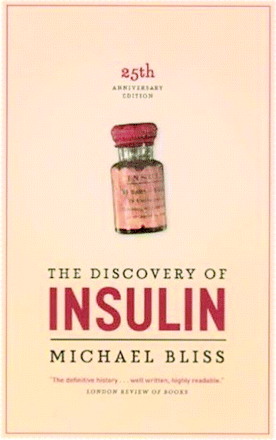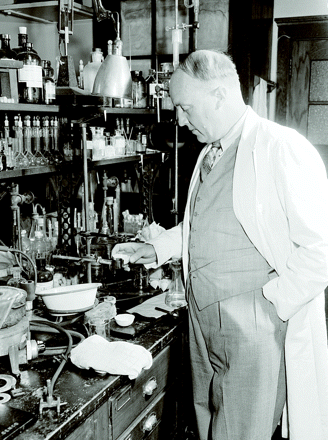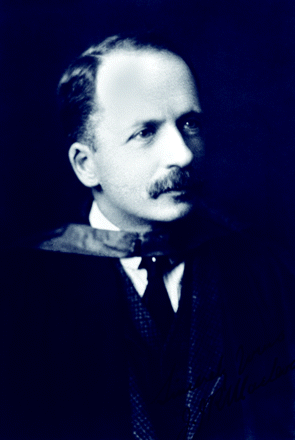Insulin Shock
- John Nelson, PhD, Is Associate Editor Of Molecular Interventions

The Discovery of Insulin Twenty-fifth Anniversary Edition Michael Bliss University of Chicago Press 2007, 310 pages. $22.50, ISBN-13: 978-0226058993
Just as scientific endeavor is a process of discovery, so, too, is the writing of lives and histories. First comes the interest in the problem. Second is the reading of what has come before. Next is the identification of empty spots where pieces are missing from the puzzle of understanding. Here, the investigator must have a plan or hypothesis about the picture that promises to develop. Sometimes, the process will demand more than a plan, and sheer intuition will be key. One must be prepared to accept pieces that are essential and to place them properly; one must be prepared to discard pieces that are extraneous to the picture. And at some point, the picture, hole-ridden or complete, has to be shared. Truth, in science as in art, is always a group project.

Surely, authors of biographies have proceeded, thinking the construction of their manuscript had reached a point where it was a matter of filling in gaps to finish the narrative. Or perhaps that it was a small matter of finding a few points to support their supposition when evidence was not concrete. At these times, a scrap of evidence to the contrary threatens to derail the project or, at least, garners pause long enough to consider alternative hypotheses.
Like the author/investigator, the engaged reader may also fall into the trap of expectation. In picking up a book, the reader enters a tacit contract with the author: time reading will be time well spent. The nonfiction author’s job is not necessarily to write something that we agree with political musings, notwithstanding but to provoke and test the depth of what we believe we think.
Believing that I already knew the basic history of insulin’s discovery, I thought Michael Bliss’s book would provide some gap-filling data of which I was unaware and provide a useful title for Beyond the Bench. Most know that Frederick Banting and Charles Best worked with dogs, removing their pancreases, extracting the “internal secretion” that contained insulin, giving injections of extracts to depancreatized dogs. The two collaborators became famous for successfully treating their animal models of diabetes, and the purification of insulin for use in patients provided the inevitable happy ending for the story, capped with a Nobel Prize.
In fact, the full story is far, far more complicated and involves more than two protagonists. Indeed, there was an existing literature dating back to the late 1800s on diabetes and the likely role of the pancreas in its origin.
In late October, 1920, Banting read an article on the islets of Langerhans and their relation to diabetes, published in a medical journal he had received early that day. Of interest was the finding, during an autopsy, that a rare pancreatic stone had blocked the corpse’s main pancreatic duct and that although the acinar cells of the pancreas had atrophied, the islet cells appeared intact. Additionally, the corpse was found not to have suffered from the effects of diabetes. Banting hit upon the idea of ligating the duct as a way to increase the relative proportion of “internal secretion,” which contained insulin, to that of the “external secretion,” which emptied into the duodenum to aid digestion and which had nothing to do with the anti-diabetic properties of the pancreas.
The story gets complicated soon after when Banting, who seems to have suffered from constant insecurity and possessed a very short-fused temper, looked to secure a small lab/ operating space and a few dogs. He approached J.J.R. Macleod a well-regarded physiologist at the University of Toronto who had written on diabetes and certainly was aware of the state of diabetes research in the available literature. Macleod agreed to give Banting a space to pursue his experiments, and Master’s student Charles Best was assigned to help Banting.
It was some time before Banting and Best were able to keep the dogs from dying soon after partial pancreatectomy surgery. Bliss’s historical evidence is that Banting had an idea but neither he nor Best possessed the rigorous scientific training necessary to know what questions should be asked and in what order they should be answered. They could not sort the puzzle pieces that they found, and they did not know where to find pieces that were missing. Indeed, they misinterpreted their results on more than one occasion, resulting in much wasted time. Macleod’s role was crucial. He offered sound advice and kept them focused on designing and conducting the proper experiments. Macleod’s help was invaluable to them and, indeed, they would likely have been scooped by other researchers around the world working to isolate insulin (called “isletin” by Banting at the time) and prove its clinical worth.
Enter J.B. Collip, another sine qua non. Collip was a trained biochemist and professor on sabbatical from the University of Alberta. His knowledge was critically important for the successful purification of insulin from the detritus of pancreatic extract. He found that the active fraction stayed in solution in alcohol even up to 90%. Above a concentration of 90% ethanol, insulin precipitated, allowing for a major refinement of the process and greater purity of active product.
The challenge was exacerbated by Banting’s mistrust of those he thought were trying to take over his project. It comes as a shock to the reader when Collip announces he had made a successful breakthrough in the purification of insulin but tells Banting that he won’t reveal it. That Collip and Macleod share lunch daily to the exclusion of Banting only fuels Banting’s misgivings and paranoia. To Banting’s great fury, Banting and Macleod are bestowed the Nobel Prize in Physiology or Medicine. Macleod, to Banting’s mind, deserved no fame, but what is clear from Bliss’s narrative is how important Macleod was to the proper scientific progress and promotion of the story to the press and scientific colleagues Banting was a poor public speaker and did not convey the group’s findings well. Banting also was livid that Best was not a co-awardee and immediately shared his award with him. Collip, also left out in the cold, certainly was worthy of sharing the prize. Without his accomplishments, the research would have foundered. Indeed, Macleod shared his award with Collip. And this is only a fraction of the rich story.
Just as when a scientist hits an unexpected dead-end or has inconclusive results, the author, too, has to solve multiple points of view and make inferences about actions alluded to but never explicated. The scientists at the heart of insulin’s discovery and The Discovery of Insulin rise above the difficulties and acquits itself well; and the reader-author contract is fulfilled.
- © American Society for Pharmacology and Experimental Theraputics 2008







